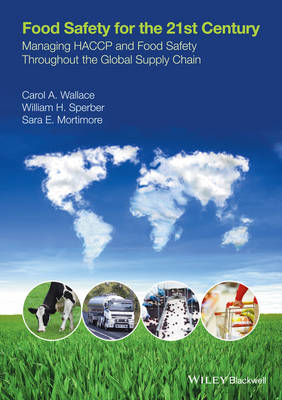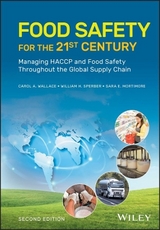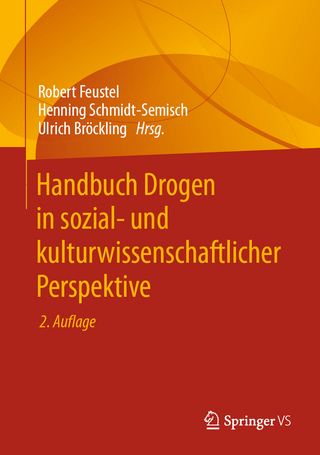
Food Safety for the 21st Century
John Wiley & Sons Inc (Verlag)
978-1-118-89798-0 (ISBN)
- Titel ist leider vergriffen;
keine Neuauflage - Artikel merken
This book:
Provides a practical and up–to–date text covering the essentials of food safety management in the global supply chain, giving the reader the knowledge and skills that they need to design, implement and maintain a world–class food safety programme.Builds on existing texts on HACCP and food safety, taking the next step forward in the evolution of HACCP and providing a text that is relevant to all sectors and sizes of food businesses throughout the world.Shares practical food safety experience, allowing development of best–practice approaches. This will allow existing businesses to improve their systems and enable businesses that are new to HACCP and food safety management requirements in both developed and developing countries to build on existing knowledge for more rapid application of world–class food safety systems.Educates practitioners such that they will be able to use their judgement in decision–making and to influence those who make food policy and manage food operations.
This book is an essential resource for all scientists and managers in the food industry (manufacturing and foodservice); regulators and educators in the field of food safety; and students of food science and technology.
Sara .E. Mortimore, Vice President Quality and Regulatory Affairs, Land O'Lakes, Saint Paul, Minnesota, USA Carol A. Wallace, University of Central Lancashire, UK William H. Sperber, Cargill, USA
Preface xiii
Acknowledgements xv
Disclaimer xv
How to use this book xvi
The authors xviii
Glossary of terms and acronyms xx
PART ONE FOOD SAFETY CHALLENGES IN THE 21ST CENTURY 1
1 Origin and evolution of the modern system of food safety management: HACCP and prerequisite programmes 3
1.1 Historical perspectives 3
1.2 Origin and evolution of HACCP 5
1.3 The necessity of prerequisite programmes 10
1.4 The future of HACCP 10
2 Lessons learned from food safety successes and failures 12
2.1 Introduction 12
2.2 Benefits of using HACCP lessons learned from successful implementation 12
2.3 Misconceptions or ′failure to understand HACCP′ 14
2.4 Barriers to effective HACCP use 20
2.5 Reasons for failure 21
2.6 Difficulties with applying HACCP through the entire food supply chain 24
2.7 Roles and responsibilities lessons learned 26
2.8 Conclusions 28
3 Food safety challenges in the global supply chain 30
3.1 Introduction 30
3.2 Increased complexity of the global supply chain 32
3.3 Food safety issues in global trade 37
3.4 Strategic–level responses 41
3.5 Tactical level responses 43
3.6 Conclusions 46
4 The future of food safety and HACCP in a changing world 48
4.1 Introduction 48
4.2 Food safety issues 49
4.3 Technology advancements 50
4.4 Food safety management 51
4.5 Changes in thinking/policy making 59
4.6 Conclusions 61
PART TWO FOODBORNE HAZARDS AND THEIR CONTROL 63
5 Recognising food safety hazards 65
5.1 Introduction 65
5.2 Biological hazards 66
5.3 Chemical hazards 78
5.4 Physical hazards 85
5.5 Conclusions 86
6 Designing safety into a food product 87
6.1 Introduction 87
6.2 Formulation intrinsic control factors 87
6.3 Use of experimental design and analysis 97
6.4 Ingredient considerations 102
6.5 Conclusions 104
7 Designing a safe food process 105
7.1 Introduction 105
7.2 Process control of microbiological hazards 106
7.3 Process control of chemical hazards 117
7.4 Process control of physical hazards 119
7.5 Conclusion 122
PART THREE SYSTEMATIC FOOD SAFETY MANAGEMENT 123
8 Overview of a world–class food safety programme 125
8.1 Introduction 125
8.2 Preliminary concepts and definitions 126
8.3 World–class food safety programmes in the global food supply chain 130
8.4 Continuous improvement of the world–class food safety programme 131
8.5 Conclusions 132
9 Building the foundations of a world–class food safety management programme: essential steps and practices 133
9.1 Introduction 133
9.2 Essential management practices 135
9.3 Preparation activities for food safety programmes 143
9.4 Prioritisation of corrective actions 150
9.5 Conclusions 152
10 Formalised prerequisite programmes in practice 154
10.1 Introduction 154
10.2 Prerequisite definitions and standards 154
10.3 Prerequisite programmes the essentials 155
10.4 Prerequisite programmes and operational prerequisites 173
10.5 Validation and verification of prerequisite programmes 175
10.6 Conclusions 175
11 Conducting a product safety assessment 176
11.1 Introduction 176
11.2 Training for research and development personnel 179
11.3 Example of a product safety assessment 179
11.4 Conclusions 184
12 Developing a HACCP plan 185
12.1 Introduction 185
12.2 Preliminary concepts 186
12.3 Applying the codex logic sequence to develop a HACCP plan 189
12.4 Conclusions 215
13 Implementing a HACCP system 216
13.1 Introduction 216
13.2 Activities for implementation of a HACCP plan 217
13.3 Considerations for implementing updates and changes to an existing HACCP system 223
13.4 Conclusions 223
14 Maintaining a food safety programme 224
14.1 Introduction 224
14.2 What is food safety programme maintenance? 224
14.3 Responsibility for food safety programme maintenance 225
14.4 Maintenance of prerequisite programme elements 226
14.5 Maintenance of HACCP system elements 226
14.6 Use of audit for successful food safety system maintenance 228
14.7 Incident Management 233
14.8 Conclusions 233
References 235
PART FOUR APPENDICES 245
Appendix 1 HACCP case studies 247
Introduction 247
Case study 1: Shell eggs food safety case study 249
Case study 2: Manufacturing prepared meals 271
Case study 3: Food service Lapland UK food service operation 293
Case study 4: Food safety in the home: a review and case study 303
Appendix 2 Global food safety resources 311
Index 315
| Verlagsort | New York |
|---|---|
| Sprache | englisch |
| Maße | 173 x 242 mm |
| Gewicht | 688 g |
| Themenwelt | Sozialwissenschaften ► Soziologie |
| Technik ► Lebensmitteltechnologie | |
| ISBN-10 | 1-118-89798-6 / 1118897986 |
| ISBN-13 | 978-1-118-89798-0 / 9781118897980 |
| Zustand | Neuware |
| Haben Sie eine Frage zum Produkt? |
aus dem Bereich



